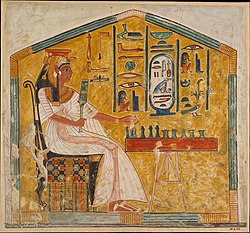
Back কিউভি৬৬ Bengali/Bangla QV66 Danish QV66 German QV66 Spanish QV66 Finnish QV66 French Királynék völgye 66 Hungarian QV66 Armenian QV66 Italian QV66 Portuguese
| QV66 | |
|---|---|
| Burial site of Nefertari | |
 Nefertari playing Senet | |
| Coordinates | 25°43′40.3″N 32°35′33.4″E / 25.727861°N 32.592611°E |
| Location | Valley of the Queens |
| Discovered | 1904 |
| Decoration | Book of the Dead |
| Layout | Generally straight |
← Previous QV65 Next → QV67 | |
QV66 is the tomb of Nefertari, the Great Wife of Pharaoh Ramesses II, in Egypt's Valley of the Queens. It was discovered by Ernesto Schiaparelli (the director of the Egyptian Museum in Turin) in 1904. It is called the Sistine Chapel of Ancient Egypt.[citation needed] Nefertari, which means "beautiful companion", was Ramesses II's favorite wife; he went out of his way to make this obvious, referring to her as "the one for whom the sun shines" in his writings, built the Temple of Hathor to idolize her as a deity, and commissioned portraiture wall paintings. In the Valley of the Queens, Nefertari's tomb once held the mummified body and representative symbolisms of her, consistent with most Egyptian tombs of the period. Now, everything had been looted except for two thirds of the 5,200 square feet of wall paintings. For what still remains, these wall paintings characterized Nefertari's character. Her face received particular attention to emphasize her beauty, especially the shape of her eyes, the blush of her cheeks, and her eyebrows. Some paintings were full of lines and color of red, blue, yellow, and green that portrayed exquisite directions to navigating through the afterlife to paradise.[1][2][3][4][5]
- ^ Fischer, D (June 1, 1992). "Mummy Dearest". Time. No. 22. Retrieved 29 September 2015.
- ^ Carroll, Colleen. "Clip And Save Art Notes". Arts & Activities. Retrieved 29 September 2015.
- ^ Shaw, Garry (December 2014). "Egypt reopens tomb as tourism falls". Art Newspaper. No. 263. Retrieved 29 September 2015.
- ^ "The Tomb of Nefertari". BBC. Retrieved 1 October 2015.
- ^ Wilson-Yang, K.M.; Burns, George (November 1989). "The Stability of the Tomb of Nefertari 1904-1987". Studies in Conservation. 34 (4) (4 ed.). Maney Publishing: 153–155. JSTOR 1506283.
© MMXXIII Rich X Search. We shall prevail. All rights reserved. Rich X Search
